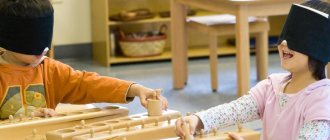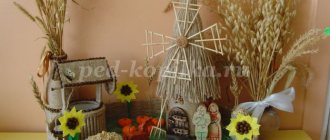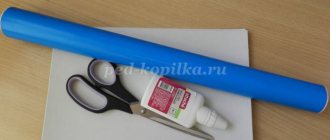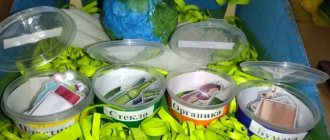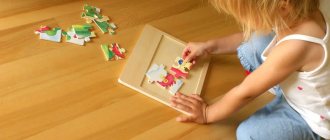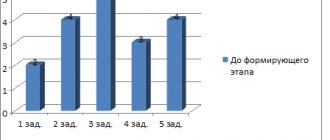According to M. Montessori, the most important task between the ages of 0 and 3 years is sensory development. During this period, children explore the world using various senses, and the main sources of information are vision and tactile perception. In order for the baby to actively develop, parents must create an environment for the child in which he could receive new and vivid sensory experiences. Sensory boxes will help make the learning environment at home even more enriched. What to fill a baby's sensory box with? How to play with her? At what age can you start playing games like this? We will answer these and other questions in this article.
What is a sensory box?
Sensory boxes are containers with various sensory fillings (liquids, bulk materials, jelly, paste, toys, etc.). This is an extremely useful and multifunctional toy for children of early and preschool age. The baby can feel small objects, pour them in, hide them, and come up with his own story. Playing with a sensory box helps develop a child's fine motor skills, attention, imagination and speech.
It is easy to make a sensory box for a child with your own hands with minimal material costs.
This educational toy can be based on any container: box, container, basin, pan. The main thing is that the child feels comfortable playing with it. Next, the container is filled with various materials (depending on the theme of the sensory box and the age of the child). Usually these are cereals, pasta, pebbles, natural materials, water, jelly, cotton wool, etc. To make it more interesting for your baby, put small toys and tools (shovels and scoops) in the “box”.
Do-it-yourself non-standard manuals for sensory development of children 2-3 years old
Non-standard aids for the sensory development of young children.
Author of the work: Zulfiya Damirovna Sanieva, teacher at the Solnyshko kindergarten, Yangelskoye village, Republic of Bashkortostan. Description of work
: non-standard toys and aids made from waste material for the sensory development of young children. The material will be of interest to educators working with children and parents. I would like to bring to your attention toys and manuals made by myself for young children. As is known, during this age period the main activity of children is object-manipulative actions, and sensory experience, as we know, is the source of knowledge of the world. Working with young children, I set myself the following tasks: - improve perception, the ability of children to actively use touch, vision, hearing; - to form children’s ideas about color, shape, size; — to develop children’s interests in didactic games, independence and focus in objective activities. Along with specially selected toys and aids that are available in the didactic corner, I also made non-standard toys that interested the children to a large extent.
"OCTOPUSY-NOISE-MAKER"
The octopus is made from Kinder Surprise capsules, tied with threads in rainbow colors, and the capsules contain fillers that sound different in all the “tentacles.” The game helps to consolidate primary colors, develop auditory perception and differentiate different sounds.
"COLLECT BEADS"
The beads are made from the caps and bodies of empty markers. Children string them on multi-colored laces, fixing the colors, training fine motor skills, and while playing they develop perseverance and determination.
"SOFT PYRAMID"
The parts of the pyramid are made of fleece fabric, they contain fillers (balls of various materials, coins, polyethylene granules from rattles, rustling foil and paper, cotton wool, etc.), and are attached to each other using Velcro. The pyramid promotes the development of fine motor skills, color perception, tactile sensations, and the consolidation of the concepts of “more” and “less”.
"LET'S FEED THE BIRDS"
The goal of the game is to feed the colorful chicks with “grains” of the same color. The game is designed to introduce and reinforce primary colors. Plastic bottles decorated with colored self-adhesive paper and appliqué “acted” as chicks, and “seeds” could be bottle caps, or in our case, mosaic chips.
"MONEY BOX"
This game is especially loved by my kids, because at this age they love to play with small objects that can be collected, poured out, sorted, etc. Here we use a bucket with a lid with slots for plastic caps from injection bottles. Naturally, everything was washed, disinfected, and processed in advance. Adult supervision is required during play. The game develops fine motor skills, the ability to act purposefully, and trains the eye.
“PICK THE LID TO THE JAR”
Vitamin jars of different sizes were used and covered with multi-colored self-adhesive paper. Children learn to unscrew and tighten lids, selecting them by color and size; here they also reinforce color and concepts of size, and train fine motor skills. To organize games at home, you can drop a little essential oils - fir, lemon, vanilla and others - into jars - this will simultaneously benefit your health and train you to develop your sense of smell.
"HOUSE FOR MOSAIC"
The game was invented after the final “death” of the floor mosaic box, and it was necessary to find a way to store multi-colored chips. I spotted the idea in some magazine, but it was improved by me in the process of making the “house”. I covered the shoe box with self-adhesive tape, cut out partitions from the remains of PVC panels, and attached them with double-sided tape to the bottom and walls of the box. I divided the lid into four multi-colored sectors and cut out windows according to the size and shape of the chips. Children match chips by color and place them in the corresponding “rooms”. When we open the lid, we can see whether we have placed the “tenants” correctly and “who ended up in the wrong house.” During the game, we also strengthen the recognition and discrimination of primary colors, coordination of movements of the fingers and hands. Dear educators, I will be glad if the ideas I proposed will be useful to you in equipping a subject-development environment. Thank you for your attention!
We recommend watching:
Didactic game for preschoolers to develop fine motor skills Do-it-yourself didactic manual for kindergarten Do-it-yourself book from a candy box. Master class with photo Do-it-yourself didactic game for kindergarten
Similar articles:
Do-it-yourself didactic games made from waste material
Do-it-yourself didactic game for preschoolers “In the world of animals”
Do-it-yourself didactic game for kindergarten on the topic “Sports”
Didactic game for children 2-3 years old “Wash the doll”
Didactic game for children 2-3 years old. Bathing a doll
Filling sensory boxes
The following can be used as the main filler for the sensory box:
- Cereals (rice, peas, millet, lentils, beans, buckwheat, semolina, etc.);
- Coffee;
- Pasta;
- Stones;
- Shells;
- Sand;
- Nuts;
- Cones;
- Dry leaves;
- Jelly;
- Water;
- Snow;
- Yarn;
- Textile;
- Vatu;
- Decorative stones for aquariums.
The more different sensations your baby gets, the more benefits for his development. Try to regularly change the contents of the sensory box to keep your child interested in playing with it.
Additional items:
- Animal figurines;
- Small toys;
- Constructor;
- Cubes;
- Letters and numbers.
Tools for playing in the sensory box:
- Bowls;
- Glasses;
- Spoons;
- Scoops;
- Rake;
- Tweezers;
- Magnifier;
- Funnel;
- Sieve.
Options for sensory boxes for children from 6 months
You can start playing with the sensory box as soon as your baby learns to sit. It is best to fill a sensory box for your baby with large and non-traumatic materials, for example, fabric, ribbons, pompoms, balls, sponges, cubes. You can also supplement it with various musical toys (bells, rattles) and something rustling (polyethylene, parchment paper).
If your baby is still small, use larger objects to fill the sensory box and carefully monitor how he plays.
For children over one and a half years old, you can use sensory boxes with cereals. At an early age, interest in small objects is especially great. Your baby will be happy to find hidden objects in the cereal. They can later be sorted by color or shape. In addition, playing with a sensory box can become training for instrumental actions: the ability to hold a spoon, pouring, and so on.
To make the filling of the sensory box brighter, you can color the rice at home. To do this, add a few drops of food coloring and 1 tablespoon of alcohol to a bag of rice (this is needed to fix the paint; the alcohol will evaporate quickly). Seal the bag tightly and stir to distribute the color evenly throughout the rice. Open the bag and wait for the cereal to dry.
If you and your child are learning the names of colors, then colored sensory boxes can be a good tool for practicing. Place different items of the same color into a container. When playing with such single-color sensory material, the baby will quickly remember the desired color.
The use of various tools and tools allows you to diversify games with the sensory box. Invite your child to play with the sieve and sift the semolina. To make it more interesting, hide small toys, pebbles or larger grains in the cereal. Using a sieve, the child must separate them from the semolina. With the help of such a game you can quickly master the concepts of “big” and “small”.
Sensory boxes filled with water cause genuine delight among children. With the help of a sieve and spoons, the baby can remove floating and sinking objects from the water, pour water into glasses, and make boats from molds and other available materials. You can add a little paint to the water - this will make playing even more fun and interesting.
Preschool children (over 3 years old) will be interested in themed sensory boxes. With their help, the child will learn new things about the world around him in a playful way. Such games are also very useful for the baby because they perfectly develop memory, attention, thinking and imagination. Here are some examples of themed sensory boxes:
- "Space"
- "Zoo"
- "Farm"
- "North Pole"
- "Construction"
Sensory development: 58 books - download to fb2, txt for Android or read online
Did you know that 26 minutes of sleep can improve your productivity by 34%? That the brain does not stop its activity during sleep and is even more active than during periods of wakefulness? That men and women perceive reality and make decisions very differently? We know very little about how our brain functions, and we do not take into account the peculiarities of its work in our daily life and professional activities.
Meanwhile, such knowledge can help us work more productively, remember more, learn better and conduct effective negotiations and presentations. Professor John Medina has formulated 12 principles of brain function, each of which we can use in everyday life.
For example, every 10 minutes the brain needs a short break in order to continue to perceive information: and the author himself skillfully uses this rule, illustrating his book with stories and examples. After reading this book, you will learn: how sleep and stress affect our brain; how we learn; that multitasking is a myth; how physical and mental exercise reduces the risk of disease; why new information is quickly forgotten and how to avoid it.
Who is this book for? For everyone who wants to live and work more efficiently. The highlight of the book is a combination of popular science topics and personal development benefits. John Medina - author of Brain Rules John Medina is a molecular evolutionary biologist who studies genes involved in brain development.
Three times recognized as the best teacher at various US universities. Director of the Center for Brain Research at Seattle Pacific University, head of the department of bioengineering at the University of Washington School of Medicine. Author of seven books. He spent most of his career as a personal research consultant and began his work studying the mental health of employees in the pharmaceutical industry.
Medina has always been fascinated by the way the brain perceives and processes information. As a husband and father of two sons, he was interested in how brain science could influence the way children learn. In addition to conducting research, consulting, and teaching, Medina devotes her time to communicating with community leaders, business and healthcare professionals, school leaders, and non-profit organizations.
Medina has served as a consultant to the US Education and Labor Committee and as a permanent representative on the relationship between the science of neuroscience and the educational system. In 2004, Medina became an affiliated fellow of the National Academy of Engineering.
In his book “Brain Rules,” John talks in an accessible way about the basic principles of the brain, which are worth knowing not only for parents and children, but also for managers. Introduction Rule No. 1. Physical activity stimulates brain function. Rule No. 2.
Survival: The human brain has evolved too Rule #3: Each person's brain has different neuronal conductivity Rule #4: We don't pay attention to the boring Rule #5: Short-term memory: repeat to remember Rule #6.
Long-term memory: remember to repeat Rule #7: Good sleep means good thinking Rule #8: Stress negatively impacts the brain's ability to learn Rule #9: Sensory integration: Engage more senses Rule #10.
Vision is more important than other sensory organs Rule #11: Gender: Men and women have different brains Rule #12: Exploration: By nature, we are great explorers.
